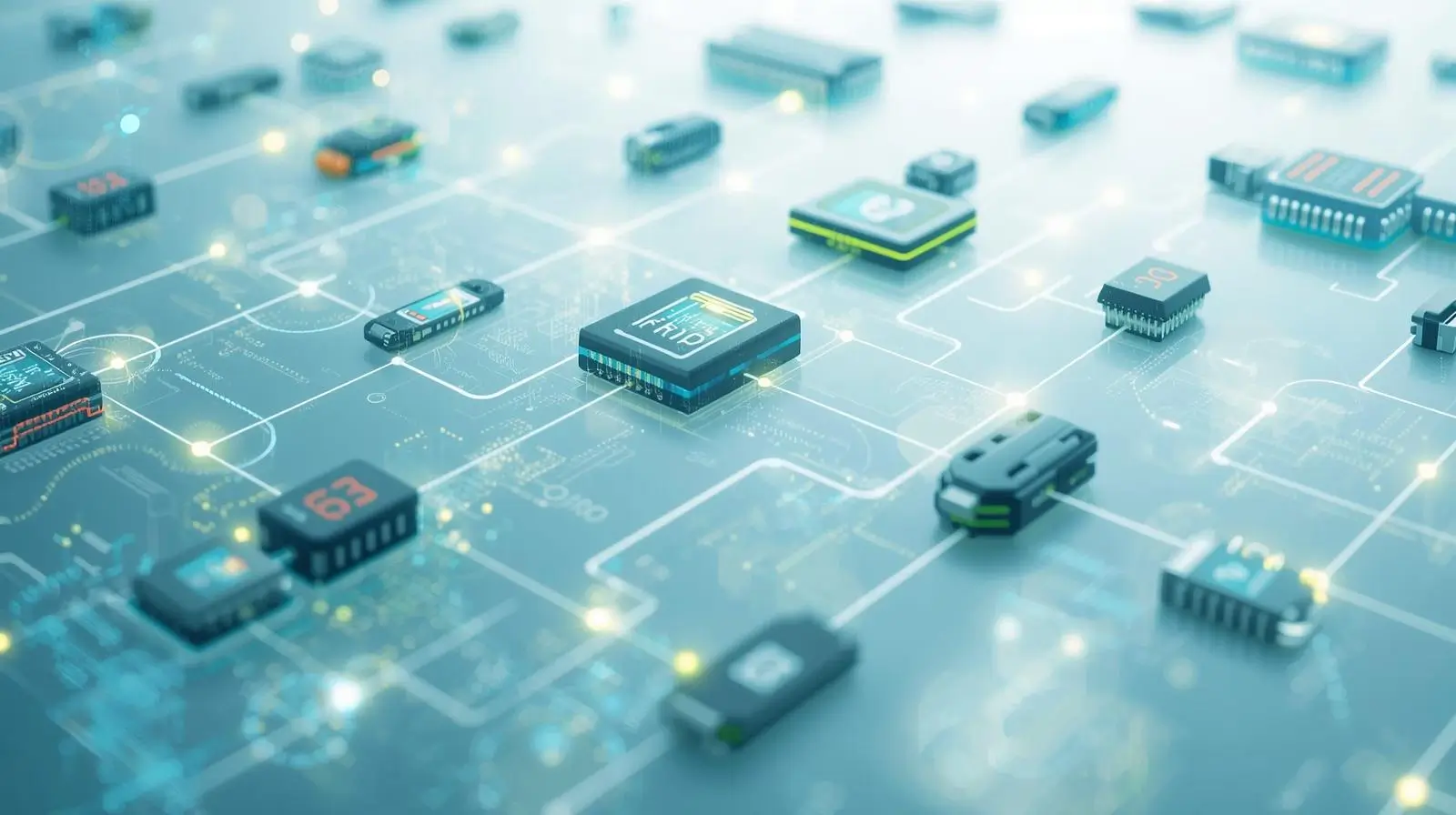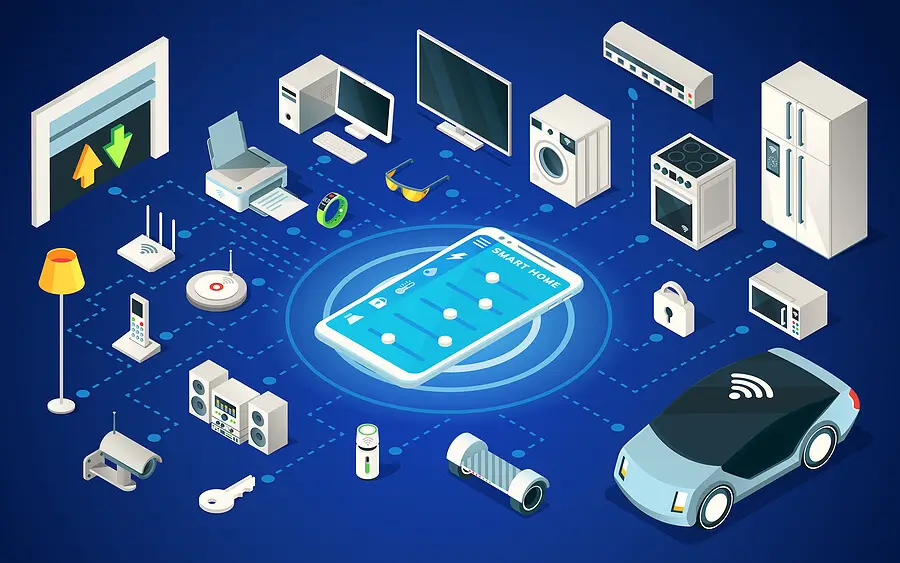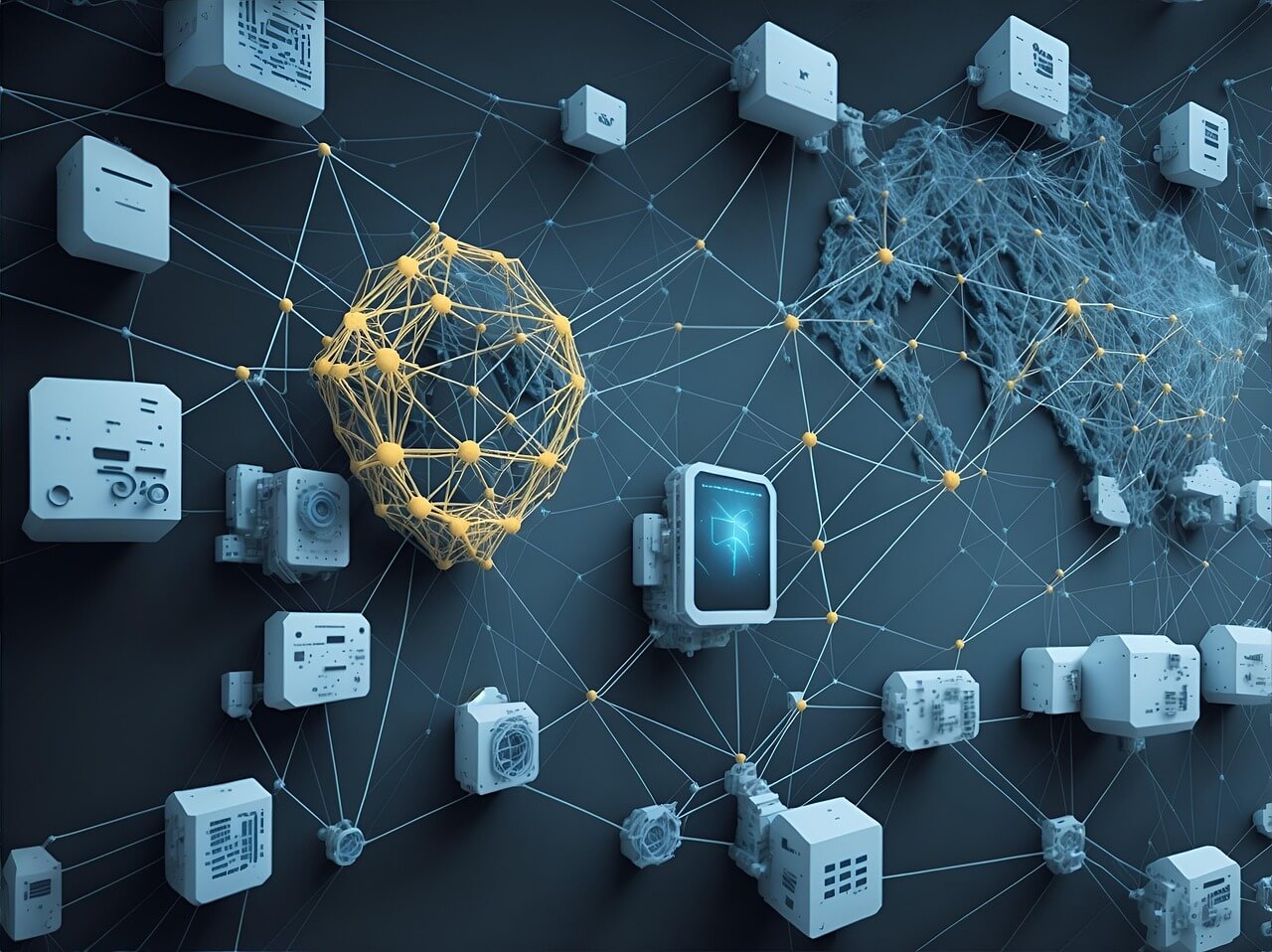RFID, or Radio Frequency Identification, is a super cool technology that’s a big part of the Internet of Things (IoT). It’s like giving objects a digital ID card that can be read wirelessly. From tracking your pet’s location to keeping tabs on products in a huge warehouse, RFID makes life easier by letting devices “talk” to each other without you lifting a finger.
In this guide, we’ll break down what RFID is, how it works, its parts, why it’s awesome, its challenges, and tons of real-world examples—all in simple, easy-to-understand language. Whether you’re curious about tech, a pet owner, or thinking about building an IoT product, this guide is for you!
⭐ What is RFID?
RFID stands for Radio Frequency Identification. It uses radio waves to identify and track objects automatically. Imagine it like a barcode, but way smarter because:
- It’s wireless (no need to point and scan).
- It’s faster (can read many items at once).
- It holds more info than a barcode.
RFID is everywhere—on your pet’s collar, in store products, or even in your car’s parking pass. It’s a key part of IoT because it helps connect physical things to the internet.
⭐ How Does RFID Work? (Super Simple)
RFID is like a conversation between a tag and a reader using radio signals. Here’s how it happens:
- An RFID tag is attached to something (like a sticker on a box or a chip in a pet’s collar).
- An RFID reader sends out radio waves to “talk” to the tag.
- The tag “replies” with its stored info (like an ID number or location).
- The reader sends this info to a computer, app, or cloud where you can see and use it.
It’s all automatic, and it happens in a split second!
⭐ The Main Parts of RFID
RFID systems have three key pieces that work together:
1️⃣ RFID Tag
- A tiny device stuck or embedded on an object (like a label, card, or pet chip).
- It has a microchip (stores data, like an ID or name) and an antenna (sends/receives signals).
- Types of Tags:
- Passive Tags: No battery, powered by the reader’s signal. Smaller, cheaper, shorter range (up to 20 meters).
- Active Tags: Have a battery, so they can send signals farther (up to 100 meters). Bigger, pricier, used for things like tracking trucks.
2️⃣ RFID Reader
- A device that sends radio waves to “wake up” tags and read their data.
- Can be handheld (like a scanner in a store) or fixed (like at a warehouse gate).
- Reads one tag or hundreds at once, depending on the setup.
3️⃣ Backend System / Cloud
- The reader sends the tag’s data to a computer, mobile app, or cloud platform.
- This is where the magic happens: you get:
- Real-time updates (e.g., “Your pet is at the park”).
- Alerts (e.g., “Low stock in aisle 5”).
- Reports or analytics (e.g., “50 items sold today”).
- In IoT, this backend connects to the internet, making the data available anywhere.
⭐ How RFID Connects with IoT
RFID becomes part of IoT when the tag’s data travels over the internet to a smart system. Here’s the flow:
RFID Tag → RFID Reader → Internet → IoT App/Dashboard
This connection lets you:
- Track things in real-time: See where your delivery truck is right now.
- Get alerts: Your phone buzzes if your pet leaves the yard.
- Analyze data: Find out which products sell fastest in your store.
- Automate tasks: Doors open automatically for tagged vehicles.
In short, RFID gives objects an identity, and IoT gives them a brain to act smart.
⭐ Where is RFID Used in IoT? (Real-World Examples)
RFID is used in so many places! Here are some exciting ways it’s making life better with IoT:
✔ 1. Smart Inventory Management
- What it does: Stores like Walmart or Zara put RFID tags on clothes, shoes, or gadgets.
- How it helps:
- Instantly know what’s in stock, sold, or needs restocking.
- No more manual counting—readers scan entire shelves in seconds.
- Reduces “out-of-stock” complaints from customers.
- Example: A store manager gets an alert on their phone when jeans are running low.
✔ 2. Asset Tracking
- What it does: Factories, hospitals, or offices tag tools, machines, or laptops.
- How it helps:
- Always know where assets are (e.g., “The drill is in Warehouse B”).
- Prevents theft or loss by tracking movement.
- Saves time searching for misplaced items.
- Example: A hospital tracks wheelchairs so they’re never “lost” when needed.
✔ 3. Logistics & Supply Chain
- What it does: Companies like Amazon or FedEx tag packages, pallets, or trucks.
- How it helps:
- Tracks shipments from factory to doorstep.
- Shows real-time location (e.g., “Your package is in Chicago”).
- Alerts for delays or wrong routes.
- Example: A delivery company knows exactly when a package arrives at a warehouse.
✔ 4. Smart Parking
- What it does: RFID cards or tags in cars let them enter parking lots automatically.
- How it helps:
- No need to roll down windows or swipe cards.
- Gates open only for authorized vehicles.
- Tracks parking usage for better management.
- Example: Your car’s RFID tag opens the office parking gate without stopping.
✔ 5. Animal & Pet Tracking
- What it does: RFID chips are in pet collars or implanted under the skin (microchips).
- How it helps:
- Identifies lost pets instantly at shelters or vet clinics.
- Tracks location if paired with GPS (in smart collars).
- Stores owner contact info or medical history.
- Example: A lost dog is scanned at a vet, and the owner is called right away.
✔ 6. Smart Library Systems
- What it does: Books, DVDs, or other items have RFID tags.
- How it helps:
- Automates borrowing and returning at self-checkout kiosks.
- Tracks book locations (e.g., “On shelf 3A”).
- Reduces theft with gate readers.
- Example: You drop a book in a return slot, and the system updates instantly.
✔ 7. Healthcare
- What it does: RFID tags are on patient wristbands, medical tools, or drug packages.
- How it helps:
- Ensures the right patient gets the right medicine.
- Tracks equipment like IV pumps so they’re always available.
- Monitors drug inventory to avoid shortages.
- Example: A nurse scans a wristband to confirm a patient’s allergy info.
✔ 8. Access Control
- What it does: RFID cards or key fobs open doors, gates, or turnstiles.
- How it helps:
- Only authorized people enter secure areas.
- Logs who enters and when.
- Works with IoT for remote access control.
- Example: Your office key card unlocks the building and tracks entry time.
✔ 9. Smart Retail
- What it does: RFID tags on products enable smart checkouts.
- How it helps:
- Customers scan all items at once (no one-by-one scanning).
- Tracks shoplifting or misplaced items.
- Improves customer experience with faster checkouts.
- Example: A grocery store lets you scan a cartful of tagged items in seconds.
✔ 10. Agriculture
- What it does: Farmers tag livestock like cows or sheep.
- How it helps:
- Tracks animal health, location, or feeding schedules.
- Monitors milk or egg production with IoT integration.
- Ensures compliance with safety regulations.
- Example: A farmer gets an alert if a cow’s tag shows it hasn’t eaten.
⭐ Benefits of Using RFID in IoT
RFID combined with IoT is a game-changer. Here’s why:
👍 1. Touchless Operation
- No need to scan, swipe, or press anything—it’s all wireless.
- Perfect for fast-paced places like stores or warehouses.
👍 2. Super Fast & Efficient
- Readers can scan hundreds of tags in a second, even through boxes or bags.
- Saves hours compared to manual counting or barcode scanning.
👍 3. Real-Time Updates
- IoT dashboards or apps show what’s happening right now.
- Example: A store app shows “10 shirts left” as soon as one is sold.
👍 4. Better Accuracy
- Cuts down on human mistakes (like miscounting stock).
- Tags store reliable data, like product IDs or expiration dates.
👍 5. Higher Security
- RFID can lock doors or restrict access to tagged items.
- Encryption keeps data safe from hackers.
- Example: Only tagged employees enter a secure lab.
👍 6. Scalability
- Works for small setups (like a pet tracker) or huge ones (like global shipping).
- Easy to add more tags or readers as needed.
👍 7. Saves Money in the Long Run
- Reduces labor costs (less manual work).
- Prevents losses from theft, misplacement, or stockouts.
⭐ Limitations of RFID
RFID isn’t perfect, but most issues can be managed. Here’s what to watch for:
👎 1. Signal Interference
- Problem: Metal (like steel shelves) or water (like wet clothes) can block radio waves.
- Solution: Use special tags designed for tough environments or adjust reader placement.
👎 2. Higher Costs
- Problem: Tags and readers cost more than barcodes (tags can be $0.10-$5 each; readers $500-$2000).
- Solution: Prices are dropping, and the time saved makes it worth it for big businesses.
👎 3. Security Risks
- Problem: Hackers could try to read tags without permission.
- Solution: Use strong encryption and secure IoT platforms to protect data.
👎 4. Range Limits
- Problem: Passive tags only work within 20 meters; active tags need battery replacements.
- Solution: Choose the right tag type for your needs (passive for short range, active for long).
👎 5. Setup Complexity
- Problem: Installing readers and integrating with IoT systems can take time.
- Solution: Work with experienced IoT providers to simplify setup.
With IoT’s smart software, these challenges are becoming less of a problem every year.
⭐ RFID vs. Barcode (Simple Comparison)
RFID and barcodes both identify things, but RFID is way more advanced. Here’s how they stack up:
| Feature | RFID | Barcode |
|---|---|---|
| Scanning | Wireless, automatic | Needs manual scan with a scanner |
| Range | Up to 20m (passive), 100m (active) | A few centimeters |
| Speed | Very fast (scans many tags at once) | Slow (one item at a time) |
| Line of Sight | Not needed (reads through boxes) | Needed (must see the barcode) |
| Cost | Higher (tags and readers) | Low (cheap stickers) |
| Data Capacity | More (stores IDs, history, etc.) | Less (just a number or code) |
| Durability | Tough (works in rain, dust) | Easily damaged (tears, fades) |
Why choose RFID? It’s faster, holds more data, and works without direct contact, making it perfect for IoT automation.
⭐ RFID + IoT = Smart Automation
When RFID teams up with IoT, you get smart automation that makes everything run smoothly. Here’s what it can create:
- Smart Warehouses: Automatically track inventory, reorder stock, and guide robots to pick items.
- Smart Homes: Pet doors open only for your tagged pet; lights turn on when your RFID keychain gets close.
- Smart Offices: Tagged badges control access and track employee attendance.
- Smart Cities: RFID in cars manages traffic, parking, or tolls without stopping.
RFID provides the identity (who or what something is), and IoT adds connectivity (linking it to apps and systems). Together, they make life faster and smarter.
⭐ Fun Facts About RFID
- It’s old but cool: RFID started in World War II to identify planes, but now it’s in everyday life.
- Tiny but powerful: Some RFID tags are as small as a grain of rice (like pet microchips).
- Eco-friendly potential: New RFID tags are being made biodegradable to reduce waste.
- Used in sports: Runners in marathons wear RFID tags to track their race times automatically.
⭐ How to Get Started with RFID in IoT
Thinking about using RFID for a project or business? Here’s a simple plan:
- Pick your goal: Want to track pets, manage stock, or secure doors?
- Choose tags: Passive for small, cheap setups; active for long-range needs.
- Get a reader: Handheld for small tasks or fixed for big systems.
- Connect to IoT: Use an app or cloud platform (like AWS IoT or Google Cloud IoT) to see and use data.
- Test small: Start with a few tags to make sure it works for you.
- Scale up: Add more tags and readers as your project grows.
You can buy RFID kits online from places like Amazon or Adafruit for as little as $50 to experiment.
⭐ Conclusion
RFID is one of the easiest and most powerful tools in IoT. It’s like giving every object a digital voice that says, “Here I am!” or “This is what I am.” When paired with IoT, it turns that voice into smart actions—like restocking a store, finding a lost pet, or opening a gate.
Whether you’re a pet owner, a business manager, or a tech enthusiast building the next big thing, RFID is a fantastic place to start. It’s already making warehouses, homes, and cities smarter, and the future is even more exciting with AI and IoT joining the party.
Ready to dive in? Try RFID for your next IoT project—it’s simple, affordable, and endlessly useful!




